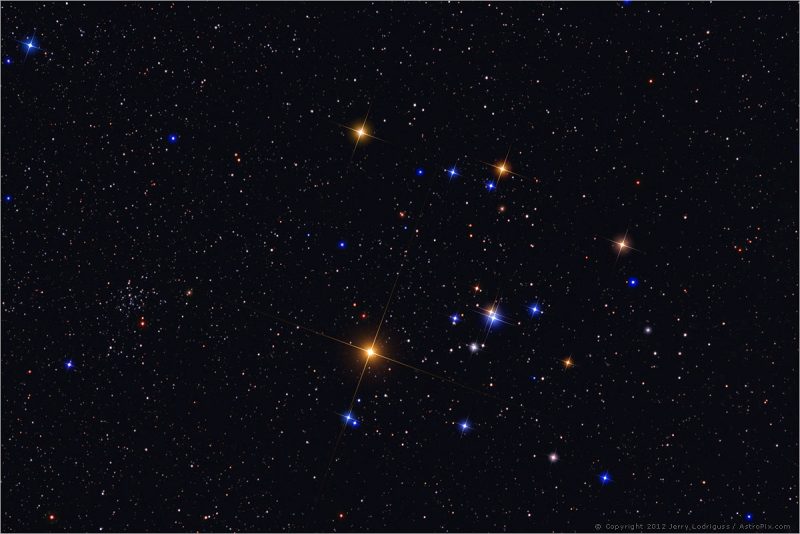
The Hyades. Copyright Jerry Lodriguss/AstroPix.com. Used with permission.
With the exception of the Ursa Major Moving Cluster, the Hyades cluster is the closest star cluster to Earth, at a distance of 150 light-years. This cluster is very easy to spot in the night sky, because it has a compact and distinctive shape of the letter V. The bright star Aldebaran is part of the V.
The V-shape represents the Face of the Bull in the constellation Taurus. Aldebaran represents the Bull’s fiery red eye.
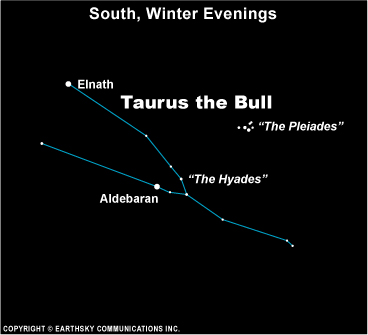
The Hyades star cluster can be found easily on January and February evenings, and is edging toward the western half of the sky by March and April evenings. It has the shape of the letter V. The brightest star in the V is Aldebaran. The small dipper-shaped Pleiades star cluster is nearby.
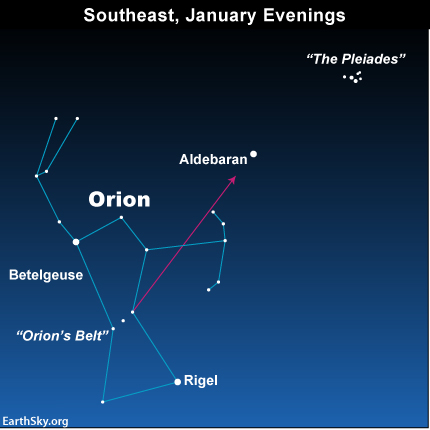
Here are Orion, the bright star Aldebaran in Taurus, and the Pleiades. Notice the three stars of Orion’s Belt, that is, three stars in a short row. Notice that these stars point to Aldebaran.
The Hyades cluster is easy to find by using Orion’s Belt, a compact and noticeable line of three blue-white stars in the constellation Orion the Hunter. Draw a line westward (generally toward your sunset direction) through the Belt stars, and you will come to the bright reddish star Aldebaran, the Bull’s fiery red eye.
Although Aldebaran isn’t a true member of the Hyades star cluster, this bright star is a great guide to this cluster. In fact, Aldebaran is only about 65 light-years distant. The Hyades lies about 2.5 times farther off.
The V-shape figure of stars (except Aldebaran) highlights the brightest of the Hyades’ few hundred stars. A dozen or more Hyades stars are visible to the unaided eye in a dark country sky, but several dozen of the cluster’s stars can be resolved through binoculars or low power in a telescope. From the Northern Hemisphere, the Hyades are best seen in the evening sky from around January to April.
The constellation Taurus the Bull is home to another bright star cluster, the Pleiades. The Pleiades cluster is more distant than the Hyades at some 430 light-years away. Both the Hyades and Pleiades are easily visible to the unaided eye. Both are enhanced by viewing with binoculars.
The Hyades – like their half-sisters the Pleiades – were nymphs of Greek mythology. Image via Greek Mythology Link – by Carlos Parada.
History and mythology of the Hyades. According to sky lore, the teary Hyades are the daughters of Atlas and Aethra, who are forever crying for their brother Hyas, who was killed by a lion or a boar. The Hyades are the half-sisters to the Pleiades, the daughters of Atlas and Pleione. The gods purposely kept Atlas’ daughters – the Hyades and the Pleaides – out of reach of Orion, giving them a safe haven from his lustful pursuits.
The gods transformed Hyas into the constellation Aquarius, and the lion that killed him into the constellation Leo. The gods placed Aquarius and Leo on opposite sides of the sky for Hyas’ protection. That’s why Aquarius and Leo do not appear in the same sky together. As one constellation sets in the west, the other rises in the east – and vice versa.
View larger. | David Rojas in Guatemala City, Guatemala caught the waxing crescent moon, Hyades star cluster with the bright star Aldebaran at one tip of the V, and the Pleiades star cluster on March 22, 2018.
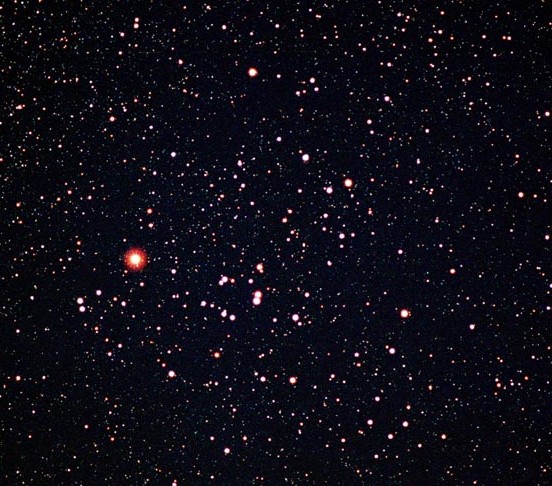
A telescope reveals over 100 stars in the Hyades cluster. The bright red star here is Aldebaran. Photo via astronomycafe.net.
Hyades science. Although the Hyades and Pleaides are half-sisters in mythology, science finds no close relationship in space between these two star clusters.
Astronomers find that the Pleiades are composed of hot blue-white suns in the heyday of youth, which puts the age of the cluster at about 100 million years. In contrast, the cooler red giant and white dwarf stars found in the Hyades indicate a vastly older cluster over 700 million years old.
Interestingly, astronomers suspect an actual kinship between the Hyades cluster and the Beehive star cluster in the constellation Cancer the Crab. Even though these two star clusters are separated from one another by hundreds of light-years, they are akin in age and travel in a similar direction in space. Astronomers believe these clusters might have originated from the same gaseous nebula some 700 to 800 million years ago.

The three bright stars in a row are Orion’s Belt. They point to the Hyades star cluster. Photo via Unishot/Flickr.
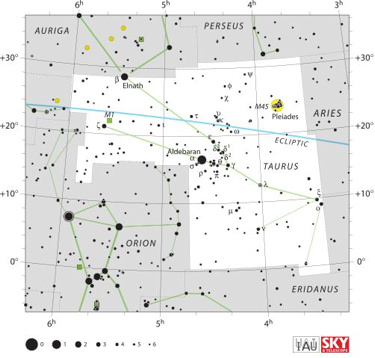
View larger. | More detail on the starry sky around the Hyades. Notice that Orion’s Belt (lower left) points to the Hyades.
Enjoying EarthSky? Sign up for our free daily newsletter today!
Bottom line: On January and February evenings, look for a V-shaped pattern of stars. The Hyades star cluster represents the face of Taurus the Bull. The cluster is easy to spot and beautiful in binoculars.
from EarthSky http://bit.ly/2MHDSbJ

The Hyades. Copyright Jerry Lodriguss/AstroPix.com. Used with permission.
With the exception of the Ursa Major Moving Cluster, the Hyades cluster is the closest star cluster to Earth, at a distance of 150 light-years. This cluster is very easy to spot in the night sky, because it has a compact and distinctive shape of the letter V. The bright star Aldebaran is part of the V.
The V-shape represents the Face of the Bull in the constellation Taurus. Aldebaran represents the Bull’s fiery red eye.

The Hyades star cluster can be found easily on January and February evenings, and is edging toward the western half of the sky by March and April evenings. It has the shape of the letter V. The brightest star in the V is Aldebaran. The small dipper-shaped Pleiades star cluster is nearby.

Here are Orion, the bright star Aldebaran in Taurus, and the Pleiades. Notice the three stars of Orion’s Belt, that is, three stars in a short row. Notice that these stars point to Aldebaran.
The Hyades cluster is easy to find by using Orion’s Belt, a compact and noticeable line of three blue-white stars in the constellation Orion the Hunter. Draw a line westward (generally toward your sunset direction) through the Belt stars, and you will come to the bright reddish star Aldebaran, the Bull’s fiery red eye.
Although Aldebaran isn’t a true member of the Hyades star cluster, this bright star is a great guide to this cluster. In fact, Aldebaran is only about 65 light-years distant. The Hyades lies about 2.5 times farther off.
The V-shape figure of stars (except Aldebaran) highlights the brightest of the Hyades’ few hundred stars. A dozen or more Hyades stars are visible to the unaided eye in a dark country sky, but several dozen of the cluster’s stars can be resolved through binoculars or low power in a telescope. From the Northern Hemisphere, the Hyades are best seen in the evening sky from around January to April.
The constellation Taurus the Bull is home to another bright star cluster, the Pleiades. The Pleiades cluster is more distant than the Hyades at some 430 light-years away. Both the Hyades and Pleiades are easily visible to the unaided eye. Both are enhanced by viewing with binoculars.
The Hyades – like their half-sisters the Pleiades – were nymphs of Greek mythology. Image via Greek Mythology Link – by Carlos Parada.
History and mythology of the Hyades. According to sky lore, the teary Hyades are the daughters of Atlas and Aethra, who are forever crying for their brother Hyas, who was killed by a lion or a boar. The Hyades are the half-sisters to the Pleiades, the daughters of Atlas and Pleione. The gods purposely kept Atlas’ daughters – the Hyades and the Pleaides – out of reach of Orion, giving them a safe haven from his lustful pursuits.
The gods transformed Hyas into the constellation Aquarius, and the lion that killed him into the constellation Leo. The gods placed Aquarius and Leo on opposite sides of the sky for Hyas’ protection. That’s why Aquarius and Leo do not appear in the same sky together. As one constellation sets in the west, the other rises in the east – and vice versa.
View larger. | David Rojas in Guatemala City, Guatemala caught the waxing crescent moon, Hyades star cluster with the bright star Aldebaran at one tip of the V, and the Pleiades star cluster on March 22, 2018.

A telescope reveals over 100 stars in the Hyades cluster. The bright red star here is Aldebaran. Photo via astronomycafe.net.
Hyades science. Although the Hyades and Pleaides are half-sisters in mythology, science finds no close relationship in space between these two star clusters.
Astronomers find that the Pleiades are composed of hot blue-white suns in the heyday of youth, which puts the age of the cluster at about 100 million years. In contrast, the cooler red giant and white dwarf stars found in the Hyades indicate a vastly older cluster over 700 million years old.
Interestingly, astronomers suspect an actual kinship between the Hyades cluster and the Beehive star cluster in the constellation Cancer the Crab. Even though these two star clusters are separated from one another by hundreds of light-years, they are akin in age and travel in a similar direction in space. Astronomers believe these clusters might have originated from the same gaseous nebula some 700 to 800 million years ago.

The three bright stars in a row are Orion’s Belt. They point to the Hyades star cluster. Photo via Unishot/Flickr.

View larger. | More detail on the starry sky around the Hyades. Notice that Orion’s Belt (lower left) points to the Hyades.
Enjoying EarthSky? Sign up for our free daily newsletter today!
Bottom line: On January and February evenings, look for a V-shaped pattern of stars. The Hyades star cluster represents the face of Taurus the Bull. The cluster is easy to spot and beautiful in binoculars.
from EarthSky http://bit.ly/2MHDSbJ

Aucun commentaire:
Enregistrer un commentaire